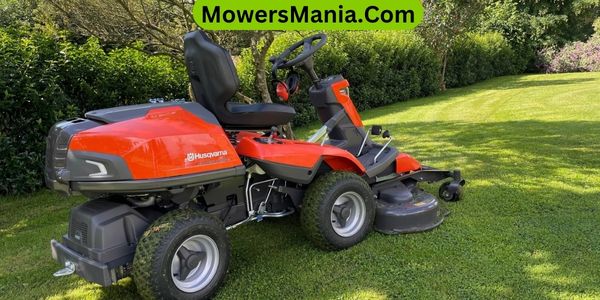Are you struggling to start your riding lawn mower that’s been sitting for years? Don’t worry, we’ve got you covered.
In this article, we’ll show you how to bring that old mower back to life and get it running smoothly again. With a few simple steps and some basic tools, you’ll be able to start your mower and have your lawn looking pristine in no time.

So let’s get started!
Gather the Necessary Tools and Supplies
First, you’ll frequently need to gather the necessary tools and supplies to start a riding lawn mower that has been sitting for years.
Before you begin, make sure you have a set of basic hand tools, such as a socket wrench, pliers, and screwdrivers. These tools will come in handy when you need to remove parts or tighten connections.
Additionally, you’ll need a fresh spark plug, a new air filter, and a can of fuel. The spark plug is essential for igniting the fuel in the engine, while the air filter ensures that only clean air enters the combustion chamber.
It’s also important to have a can of fuel on hand to fill up the mower’s tank. Make sure you use fresh fuel, as old fuel can cause starting problems.
Lastly, don’t forget to grab a pair of safety goggles and work gloves to protect yourself while working on the mower. By gathering these tools and supplies, you’ll be well-prepared to tackle the task of starting a riding lawn mower that has been sitting for years.
Inspect the Lawn Mower for Any Damage
Before you begin, when inspecting the lawn mower for any damage, ask yourself: How long has the mower been sitting unused?
This is an important question because the longer it has been sitting, the more likely it’s to have some damage or issues that need to be addressed before you can start it up again.
Here are some key things to look out for during the inspection:
- Check the battery: If the mower has been sitting for years, chances are the battery might be dead or damaged. Inspect the battery for any signs of corrosion or leakage. If necessary, replace it with a new one.
- Examine the fuel system: Old gasoline can become stale and cause problems with starting the mower. Drain the old fuel and replace it with fresh gasoline. Inspect the fuel lines and filter for any clogs or damage.
- Inspect the spark plug: Remove the spark plug and check for any signs of damage or wear. Replace it if necessary.
- Assess the blades and belts: Look for any signs of rust, cracks, or excessive wear on the blades and belts. Replace them if needed to ensure safe and efficient operation.
Drain and Replace the Old Fuel
Now that you have inspected the lawn mower for any damage, how do you drain and replace the old fuel?
It’s essential to remove the old fuel before attempting to start a riding lawn mower that has been sitting for years. The fuel can break down over time, causing engine problems. Follow these steps to drain and replace the old fuel.
First, locate the fuel tank. Typically, it’s located near the engine or under the seat. Once you’ve found it, place a container underneath to catch the fuel. Next, locate the fuel line connected to the tank and detach it. Use pliers if necessary.
With the fuel line disconnected, allow the old fuel to drain completely into the container. Be patient, as this may take some time. Once the tank is empty, dispose of the old fuel properly according to local regulations.
Now that the tank is empty, it’s time to replace the fuel. Fill it with fresh gasoline, ensuring you use the correct type recommended by the manufacturer. Avoid using old or stale fuel, as it can cause starting issues.
After filling the tank, reattach the fuel line securely. Check for any leaks or loose connections. Now, your riding lawn mower is ready for the next step in the process: checking the oil level.
Check and Replace the Spark Plug if Necessary

To ensure optimal performance, check the spark plug for any signs of damage or wear before attempting to start your riding lawn mower that has been sitting for years.
The spark plug plays a crucial role in igniting the fuel-air mixture in the engine’s combustion chamber. Over time, the spark plug can become fouled or worn out, leading to difficulties in starting the mower.
Here are four steps to help you check and replace the spark plug if necessary:
- Locate the spark plug: Consult your mower’s manual to find the exact location of the spark plug. Typically, it’s located near the engine’s cylinder head and can be easily spotted by its wire.
- Remove the spark plug: Use a spark plug socket wrench to loosen and remove the plug. Be careful not to damage the plug or the surrounding components.
- Inspect the spark plug: Examine the electrode and the insulator for any signs of damage, such as cracks, carbon deposits, or excessive wear. If you notice any of these issues, it’s time to replace the spark plug.
- Replace the spark plug: Purchase a new spark plug that matches your mower’s specifications. Install the new plug by hand, then use the spark plug socket wrench to tighten it securely.
Clean or Replace the Air Filter
To maintain optimal performance, it’s essential to clean or replace the air filter on your riding lawn mower that has been sitting for years.
The air filter is responsible for keeping dirt, debris, and other particles from entering the engine and causing damage. Over time, the air filter can become clogged with dirt and lose its efficiency.
This can lead to reduced airflow to the engine, resulting in poor performance and potential engine damage.
To clean the air filter, start by removing it from the mower. Inspect the filter for any signs of damage, such as holes or tears.
If the filter is damaged, it’s best to replace it with a new one. If the filter is in good condition, you can clean it by gently tapping it on a hard surface to remove loose debris. Then, use compressed air or a soft brush to remove any remaining dirt or debris.
If you decide to replace the air filter, make sure to purchase the correct filter for your specific mower model. Refer to the owner’s manual or consult a professional if you’re unsure.
Installing the new filter is a straightforward process and usually involves sliding it into place and securing it with any clips or fasteners.
Start the Engine and Perform a Test Run

Now that you’ve cleaned or replaced the air filter, it’s time to start the engine and perform a test run.
This is an important step to ensure that everything is working properly before you start mowing your lawn.
In this section, we’ll discuss some engine maintenance tips, fuel system troubleshooting, and proper storage techniques to help you get your riding lawn mower up and running smoothly.
Engine Maintenance Tips
Start by ensuring that you have all the necessary tools and materials ready. To properly maintain your riding lawn mower’s engine, follow these tips:
- Check the oil: Before starting the engine, make sure the oil level is adequate. If it’s low, add the recommended type of oil.
- Clean the air filter: Over time, the air filter can get clogged with dirt and debris. Remove it and clean or replace it if necessary.
- Inspect the spark plug: A worn or dirty spark plug can affect the engine’s performance. Remove it and check for any signs of damage or buildup. Replace if needed.
- Drain and replace the fuel: If the mower has been sitting for years, the fuel may have gone bad. Drain the old fuel and replace it with fresh gasoline.
Fuel System Troubleshooting
Have you checked if the fuel system is functioning properly on your riding lawn mower that has been sitting for years?
Before attempting to start the engine, it’s crucial to troubleshoot any issues with the fuel system.
Start by checking the fuel tank for any signs of corrosion, debris, or old fuel. If necessary, drain the old fuel and replace it with fresh gasoline.
Next, inspect the fuel lines for any cracks or clogs. Replace any damaged or clogged fuel lines to ensure proper fuel flow.
Additionally, clean or replace the fuel filter to prevent any blockages.
Once you have addressed these fuel system components, you can proceed to start the engine and perform a test run to ensure everything is functioning as it should.
Proper Storage Techniques
To properly store your riding lawn mower and ensure it’s ready for use, begin by performing a test run of the engine. This will help you identify any potential issues and address them before storing the mower.
Here are some steps to follow for proper storage techniques:
- Start the engine and let it run for a few minutes to warm up the oil and lubricate the internal components.
- Check for any abnormal noises, vibrations, or smoke coming from the engine. These could indicate underlying problems that need to be addressed.
- Engage the blades and listen for any unusual sounds. Ensure that they spin freely and without any resistance.
- Test the mower’s ability to move forward and backward smoothly and effortlessly. If there are any issues with the transmission or drive system, they should be addressed before storage.
Frequently Asked Questions [FAQs]
How Long Does It Typically Take to Drain and Replace the Old Fuel in a Riding Lawn Mower?
Typically, it doesn’t take too long to drain and replace the old fuel in a riding lawn mower. Just make sure you have a container to catch the fuel and be careful not to spill.
Can I Use Any Type of Fuel to Replace the Old Fuel in My Lawn Mower?
You can’t use any type of fuel to replace the old fuel in your lawn mower. It’s important to use the correct fuel type recommended by the manufacturer to avoid damage and ensure proper functioning.
How Often Should I Clean or Replace the Air Filter in My Riding Lawn Mower?
You should clean or replace the air filter in your riding lawn mower regularly to ensure optimal performance. Neglecting this maintenance task can result in reduced engine efficiency and potential damage.
Are There Any Specific Signs of Damage I Should Look for When Inspecting My Lawn Mower?
Look for signs of damage like rust, cracks, or leaks when inspecting your lawn mower. These can indicate potential issues that may need to be addressed before starting the mower after years of sitting.
How Can I Tell if the Spark Plug in My Lawn Mower Needs to Be Replaced?
To tell if the spark plug in your lawn mower needs replacing, check for signs like difficulty starting, misfiring, or poor performance. If you notice any of these, it’s likely time for a new spark plug.
Conclusion
In conclusion, starting a riding lawn mower that has been sitting for years requires a few simple steps.
By gathering the necessary tools and supplies, inspecting for any damage, draining and replacing old fuel, checking and replacing the spark plug if necessary, and cleaning or replacing the air filter, you can successfully start the engine and perform a test run.
With a little time and effort, your lawn mower will be up and running smoothly again.



